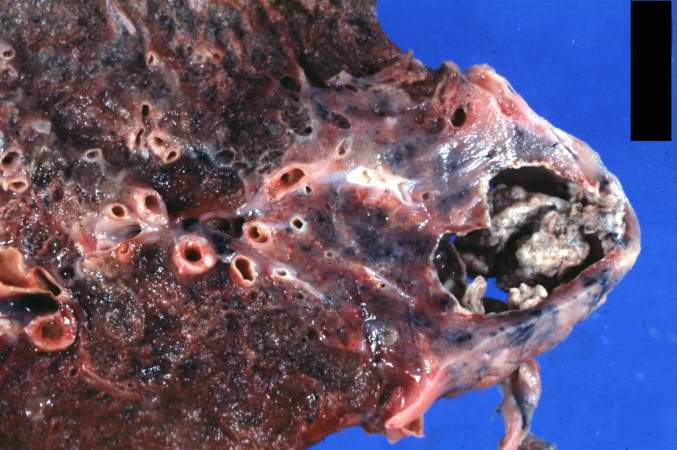Lung abscess
| Lung abscess | |
 | |
|---|---|
| Gross lung section showing apical abscess | |
| ICD-10 | J85 |
| ICD-9 | 513.0 |
| DiseasesDB | 7607 |
| eMedicine | med/1332 |
| MeSH | D008169 |
|
WikiDoc Resources for Lung abscess |
|
Articles |
|---|
|
Most recent articles on Lung abscess Most cited articles on Lung abscess |
|
Media |
|
Powerpoint slides on Lung abscess |
|
Evidence Based Medicine |
|
Clinical Trials |
|
Ongoing Trials on Lung abscess at Clinical Trials.gov Clinical Trials on Lung abscess at Google
|
|
Guidelines / Policies / Govt |
|
US National Guidelines Clearinghouse on Lung abscess
|
|
Books |
|
News |
|
Commentary |
|
Definitions |
|
Patient Resources / Community |
|
Patient resources on Lung abscess Discussion groups on Lung abscess Patient Handouts on Lung abscess Directions to Hospitals Treating Lung abscess Risk calculators and risk factors for Lung abscess
|
|
Healthcare Provider Resources |
|
Causes & Risk Factors for Lung abscess |
|
Continuing Medical Education (CME) |
|
International |
|
|
|
Business |
|
Experimental / Informatics |
Editor-In-Chief: C. Michael Gibson, M.S., M.D. [1]
Please Take Over This Page and Apply to be Editor-In-Chief for this topic: There can be one or more than one Editor-In-Chief. You may also apply to be an Associate Editor-In-Chief of one of the subtopics below. Please mail us [2] to indicate your interest in serving either as an Editor-In-Chief of the entire topic or as an Associate Editor-In-Chief for a subtopic. Please be sure to attach your CV and or biographical sketch.
Overview
Lung abscess is necrosis of the pulmonary tissue and formation of cavities (more than 2 cm)[1] containing necrotic debris or fluid caused by microbial infection.
This pus-filled cavity is often caused by aspiration, which may occur during altered consciousness. Alcoholism is the most common condition predisposing to lung abscesses.
Lung Abscess is considered primary(60%[2]) when it results from existing lung parenchymal process and is termed secondary when it complicates another process e.g. vascular emboli or follows rupture of extrapulmonary abscess into lung.
Causes
Conditions contributing to lung abscess
- Aspiration of oropharyngeal or gastric secretion
- Septic emboli
- Necrotizing pneumonia
- Vasculitis: Wegener's granulomatosis
- Necrotizing tumors: 8% to 18% are due to neoplasms across all age groups, higher in older people; primary squamous carcinoma of the lung is the commonest.
Organisms
In the post-antibiotic era pattern of frequency is changing. In older studies anerobes were found in upto 90% cases but they are much less frequent now[3].
- Anaerobic bacteria: Peptostreptococcus, Bacteroides, Fusobacterium species,
- Microaerophilic streptococcus : Streptococcus milleri
- Aerobic bacteria: Staphylococcus, Klebsiella, Haemophilus, Pseudomonas,Nocardia, Escheria coli, Streptococcus, Mycobacteria[4]
- Fungi: Candida, Aspergillus
- Parasites: Entamoeba histolytica,
Symptoms and signs
Onset of symptoms is often gradual, but in necrotizing staphylococcal or gram-negative bacillary pneumonias patients can be acutely ill. Cough, fever with shivering and night sweats are often present. Cough can be productive with foul smelling purulent sputum (≈70%) or less frequently with blood (i.e. hemoptysis in one third cases) [5]. Affected individuals may also complaint chest pain, shortness of breath, lethargy and other features of chronic illness.
Patients are generally cachectic at presentation. Finger clubbing is present in one third of patients[5]. Dental decay is common especially in alcoholics and children. On examination of chest there will be features of consolidation such as localised dullness on percussion, bronchial breath sound etc.
Diagnosis
- Chest Xray and other imaging studies
Abscess is often unilateral and single involving posterior segments of the upper lobes and the apical segments of the lower lobes as these areas are gravity dependent when lying down. Presence of air-fluid levels implies rupture into the bronchial tree or rarely growth of gas forming organism.
- Laboratory studies
Raised inflammatory markers ( high ESR, CRP) are usual but not specific. Examination of sputum is important in any pulmonary infections and here often reveals mixed flora. Transtracheal of Transbronchial (via bronchoscopy) aspirates can also be cultured. Fibre optic bronchoscopy is often performed to exclude obstructive lesion; it also helps in bronchial drainage of pus.
Management
Broadspectrum antibiotic to cover mixed flora is the mainstay of treatment. Pulmonary physiotherapy and postural drainage are also important. Surgical procedures are required in selective patients for drainage or pulmonary resection.
Complications
Rare now a days but include spread of infection to other lung segments, bronchiectasis, empyema, and bacteraemia with metastatic infection such as brain abscess[2].
Prognosis
Most cases respond to antibiotic and prognosis is usually excellent unless there is a debilitating underlying condition. Mortality from lung abscess alone is around 5% and is improving.
See also
- Other chronic lung infections
- Abscess
- Pleural effusion
External links
Reference
- ↑ Bartlett JG, Finegold SM (1972). "Anaerobic pleuropulmonary infections". Medicine (Baltimore). 51 (6): 413–50. PMID 4564416.
- ↑ 2.0 2.1 "Pneumonia and Other Pulmonary Infections: Lung Abscess, Medscape".
- ↑ Bartlett JG (2005). "The role of anaerobic bacteria in lung abscess". Clin. Infect. Dis. 40 (7): 923–5. doi:10.1086/428586. PMID 15824980.
- ↑ Hirshberg B, Sklair-Levi M, Nir-Paz R, Ben-Sira L, Krivoruk V, Kramer MR (1999). "Factors predicting mortality of patients with lung abscess". Chest. 115 (3): 746–50. PMID 10084487.
- ↑ 5.0 5.1 Moreira Jda S, Camargo Jde J, Felicetti JC, Goldenfun PR, Moreira AL, Porto Nda S (2006). "Lung abscess: analysis of 252 consecutive cases diagnosed between 1968 and 2004". Jornal brasileiro de pneumologia : publicaça̋o oficial da Sociedade Brasileira de Pneumologia e Tisilogia. 32 (2): 136–43. PMID 17273583.
Template:Respiratory pathology Template:SIB nl:Longabces fi:Keuhkopaise